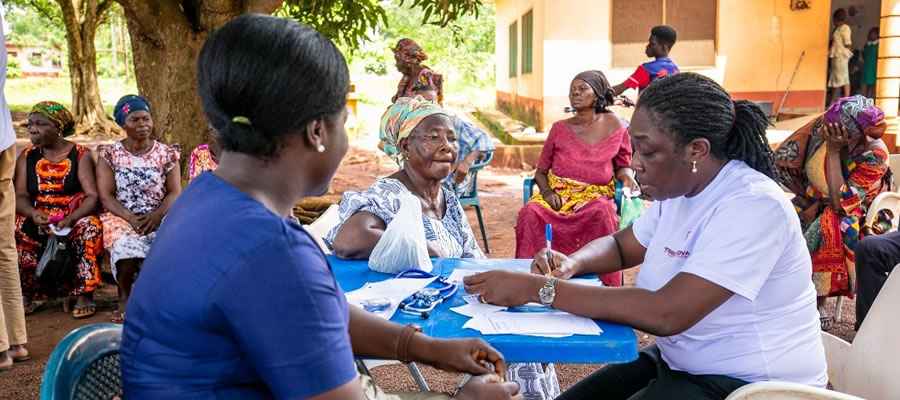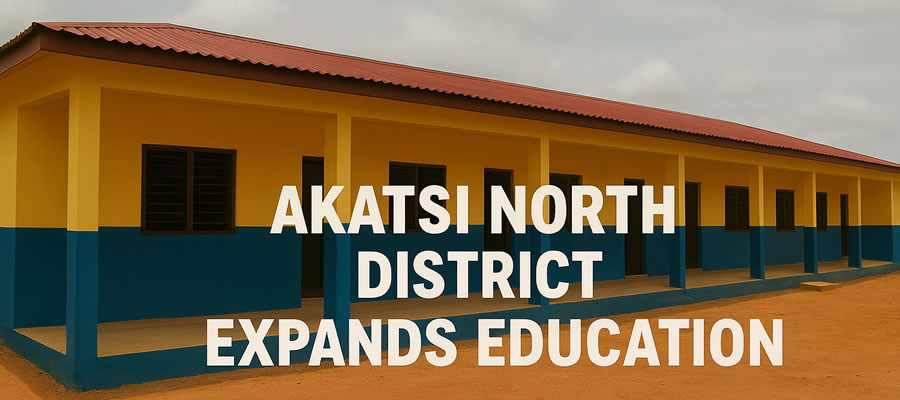
Economic activity
Information on the activity status of the population indicates that 69.9 percent of the population 15 years and older are economically active. The proportion of persons who are economically active is higher for females (52.9%) than males (47.1%). The general activity rate of 64.9% in the rural areas is much higher that of urban areas (35.1%). However, across districts, general activity rates in urban areas are higher than those in rural areas in Keta, Ketu South, Ho and Hohoe municipalities.
Of the economically active population, 67.0 percent are employed, 2.9 percent are unemployed, and 30.1 percent are not economically active. There are urban-rural differences in the proportion employed (61.0% urban against 73.1% rural). Of the 37,222 unemployed persons recorded in the region, 54.9 percent are females and 45.1 percent are males. Among the districts, the unemployment rate is highest in Jasikan (50.9%), followed by Kadjebi (48.7%) and by Nkwanta North (48.4%), while Keta Municipality recorded the lowest proportion (38.2%).
Most of the economically active population in the region are self-employed without employee(s) (72.5%), followed by those who are employees (11.2%), contributing family workers (9.8%) and self-employed with employee(s) (2.8%). People in apprenticeship, domestic work and others together constitute 2.3 percent of workers. The informal private sector is the largest employer in the region (90.6%), followed by public (government) sector (6.1%).
Occupation
Workers in skilled agriculture and related occupations are in the majority in all the districts except Keta Municipal (34.8%), Ketu South (17.3%), Ketu North (47.1%), Ho Municipality (34.4%), South Dayi (43.5%), North Dayi (38.1%), and Hohoe Municipality (43.5%). Males predominate in managerial and professional occupations (7.5% against 5.4%), while females predominate in services and sales (26.6% against 6.0%).
Industry
Agriculture/forestry/fishing is the largest industrial sector, employing more than 50 percent of the economically active population. The other two major industries are wholesale and retail trade (14.0%) and manufacturing (14.1%). The proportion of males in skilled agricultural, forestry, and fishing (57.3%) is higher than that of females (44.0%), whereas the opposite is the case for wholesale and retail trade (20.8% female and 14.0% males) and manufacturing (17.2% females and 10.6% males).
The economically active population consists of those persons who either worked for pay or profit or family gain for at least one hour within the seven days preceding Census Night. This includes persons who were in paid employment or self-employed or contributing family workers; persons who did not work but had jobs to return to; and persons who were unemployed.
The not economically active were persons who did not work and were not seeking work within the seven days preceding Census Night. This includes homemakers, students, retired persons, the disabled and persons who were unable to work due to their age or ill-health.
Economic Activity Status by Age and Sex
The 2010 PHC reported a total population of 2,118,252 for the Volta Region out of which 1,305,427 are persons 15 years and older, representing 61.6 percent of the total population. For both sexes, the table indicates that 69.9 of persons 15 years and older are economically active, while the economically inactive population constitutes 30.4%. It further shows that the proportion of persons who are economically active is higher in total for females (53.6%) than males (46.4%) and in all age groups.
The data also show that the proportion of the economically active population increases with age from 15-24 years to 35-44 years and subsequently declines with advancing age. For females, the peak of economically active population is the 25-34 years age group, while for males; the peak is the 15-24 year age group. As expected, a higher proportion of persons who are economically not active are in the younger age group (15-24 years) and older age group (65 years and older), while the lowest proportion is in the age group 35-44 years.
It is worth noting the 60.2 percent proportion of females not economically active in the 25-34 segment, in general terms perhaps the most dynamic age group.According to International LabourOrganisation (ILO) standards, the minimum age for entry into the labour force is 15 years. This is affirmed in the Children?s Act of 1998 which prohibits the engagement of children in work.
However, it is common knowledge that many children in Ghana and other parts of Africa engage in work for pay, profit, or family gain. status of children aged 5-17 years indicate that 13.2 percent of children are employed, 0.3 percent are unemployed, while 86.5 percent are economically not active in the region. It is also observed that the proportion of male children working is higher (14.2%) than that of female children (12.2%).
The percentage distribution of persons 15 years and older by economic activity status, locality and district indicates that relatively higher proportions of the males were employed as compared with the females. The data also show that persons residing in rural areas are more likely than those in urban areas to be employed and that urban dwellers are more likely than rural dwellers to become unemployed.
The general activity rate is 64.9 percent in rural areas as against 35.1 percent in urban areas. However, at district level, general activity rates are higher in urban areas than in rural areas in Keta Municipal, Ketu South, Ho Municipal and Hohoe Municipal. In the other districts, however, the rural general activity rates were higher than that of the urban. Ho, North Tongu and Akatsi districts had the highest rural general activity rates respectively. In the case of urban areas, the highest general activity rates were recorded for the Ho, Hohoe and Ketu South districts.
The Employed Population
The employed population comprises all persons aged 15 years and above who, during the reference period, were in the following categories:
At work – persons who performed some work for wage or salary either in cash or in kind or worked without pay: With a job but not at work – persons who having already worked in their present job were temporarily not at work but had a formal attachment to their job.
Employed Population by Age and Sex
It shows that the age group 35-44 years has the highest proportion of employed person (90.1%), followed by the 45-54 years age group (89.9%). It is also observed that only 49.3% of persons aged 65 years and above is employed. The lowest proportion of the employed is among the 15-24 year age group. This is expected because they are supposed to be in school or learning trades. In all age groups except 15-24, the proportion of females employed is higher than that of males and higher proportions of economically active females are employed than males in all the age groups.
The distribution of persons 15 years and older by employment status, locality and district is shown it that For the region as a whole, 67.0 percent of persons 15 years and older are employed, 2.6 percent are unemployed, and 30.4 percent are not economically active. There are urban-rural differences in the proportion employed (61.0% urban against 70.3% rural).
At district level, the majority of the economically active population is employed in all districts. However, there are variations in the proportion employed among the districts. The proportion employed ranges from 59.7 percent in Keta Municipal to 77.0 percent in Nkwanta North. The proportion of employed persons in urban areas is highest in Biakoye District (70.7%) and lowest in highly urbanized Keta (57.5%) and Ho (57.5%) municipalities. In the rural areas, Krachi East (81.4%) has the highest proportion of employed persons, while Keta Municipal has the lowest proportion (62.4%).
The percentage of persons unemployed is highest in Keta Municipality (4.2%), followed by North Dayi District (3.9%) and Ho Municipality (3.7%). Districts with substantially low proportions of unemployed persons are Nkwanta North (0.7%), Krachi West (1.1%), Nkwanta South (1.2%), Krachi East (1.4%) and Akatsi (1.7%). The data further indicate that relatively higher proportions of the economically not active population reside in the urban compared with rural areas across all the districts.
Employment Status of Employed Persons
Employment status refers to the status of a person in the establishment where he/she currently works or previously worked. The 2010 census provided seven employment status categories: employee, self-employed without employees, self-employed with employees, casual worker, contributing family worker, apprentice, domestic employee (house help). Persons who could not be classified under any of the above categories were classified as “Other”. It can be observed in all districts, over two-thirds of the employed population is self-employed without employees.
The proportion of the self-employed without employees ranges from 65.2 percent in Ho a high of 78.5 percent in AdakluAnyigbe to a low of. The rural/urban distribution shows that the proportion of self-employed with employees is higher in rural (76.1%) than in urban areas (64.8%). On the other hand, the proportion of the self-employed with employees is less than 5.0 % generally. This is observed in all the districts. Together, the two self-employed categories account for 75.3 percent of the working population. In seven districts, the proportion recorded as employees (from 11.6% to 21.4%) is higher than the regional figure (11.2%).
Occupation of Employed Persons
Occupation refers to the type of work a person was engaged in during the seven days preceding Census Night,, and those did not work but had a job to return to, as well as those unemployed who had worked before. The emphasis was on the work the person did during the reference period but not what he/she was trained to do. Data on employed persons 15 years and older by occupation and sex. It shows that workers in skilled agriculture, forestry, and fishing constitute the largest occupational group (50.1%), followed by those in craft and related trades (17.6%), and in services and sales (16.6%). On the other hand, only a small proportion of employed persons are in the technical and associated professionals (1.2%) and managerial categories (1.7%).
For both sexes, skilled agricultural, forestry, and fishery work is the dominant occupation. There are more males in managerial and professional occupations (7.5%) than females (5.4%). On the other hand, the proportion of females engaged in services and sales as workers (26.2%) is higher than that of men (6.0%).The same occupational pattern occurs in most districts, with Nkwanta North (84.4%), Krachi West (75.3%), Nkwanta South (71.2%), and Krachi East (70.1%) having relatively high proportions of employed persons engaged as skilled agricultural, forestry, and fishery workers, followed by North Tongu (62.0%). However, in Ketu South a higher proportion of the employed are engaged in craft and related trades (31.0%), followed by services and sales (28.2%) and 17.3 percent are employed in skilled agricultural, forestry and fishery.
Employment Sector
The employment sectors covered in the 2010 census were public, private formal, private informal, semi-public/parasatal, NGOs and international organizations. The distribution of persons 15 years and older by sector of employment and sex. It indicates that the informal private sector is by far the largest employer of economically active persons in the region (90.6%), followed by public (government) sector (6.1%). Less than 1 percent of employees are in semi-public/parasatal (0.1%), NGOs (0.4%) or other international organization (0.0). A similar pattern is observed for the sexes, with more males than females employed across all the sectors.
Industry of Employed Persons
The industrial activities of employed persons 15 years and older by sex indicates that agriculture, forestry and fishing is the largest industrial sector, employing more than 50 3 percent of the economically active population 15 years and older. The other two major industries are manufacturing (14.1%), and wholesale and retail trade, repair of motor vehicles and motorcycles (14.0%). For both sexes, these industries remain the major employers.
However, the proportion of males in skilled agricultural, forestry, and fishing (57.3%) is higher than that of females (44.0%), while the opposite is the case for wholesale and retail trade (20.8% of females and 6.4% of males) and manufacturing (17.2%) for females and 10.6% of males).
The Unemployed
The unemployed category comprises all persons aged 15 years and above who, during the reference period, were without work and had no fixed jobs; currently available for work; seeking work by taking specific steps to look for work (e.g. writing applications, visiting job sites, visiting employment agencies and seeking help from friends and relatives).
Unemployed Population by Age and Sex
Information on population 15 years and older by economic activity status and age group show that unemployment is highest among the younger age group (15-34 years) and lowest among the 45-54 age group. For the sexes, the proportion of females that is unemployed is higher than that of males for all age groups. This observation may reflect socio-cultural factors that do not encourage girls to enroll and remain in school to the same extent as boys and this translates into fewer opportunities in the modern labour market for females than for males.
Unemployed Population by District and Sex
More females (55.5%) than males (45.5%) are unemployed in the region. Among the districts, the proportion of the economically active male population that is unemployed is higher in Jasikan (51.4%), followed by Kadjebi (48.7%) and by Nkwanta North (46.1%), while Keta Municipal recorded the lowest proportion (37.8%). For females, the proportion of the economically active population unemployed is above 50 percent in all districts, with the exception of Jasikan (48.6%). Keta Municipal has a relatively high proportion of unemployed females (62.2%) compared to the other districts.
Date Created : 12/14/2017 5:06:00 AM












 facebook
facebook
 twitter
twitter
 Youtube
Youtube
 +233 593 831 280
+233 593 831 280 0800 430 430
0800 430 430 GPS: GE-231-4383
GPS: GE-231-4383 info@ghanadistricts.com
info@ghanadistricts.com Box GP1044, Accra, Ghana
Box GP1044, Accra, Ghana